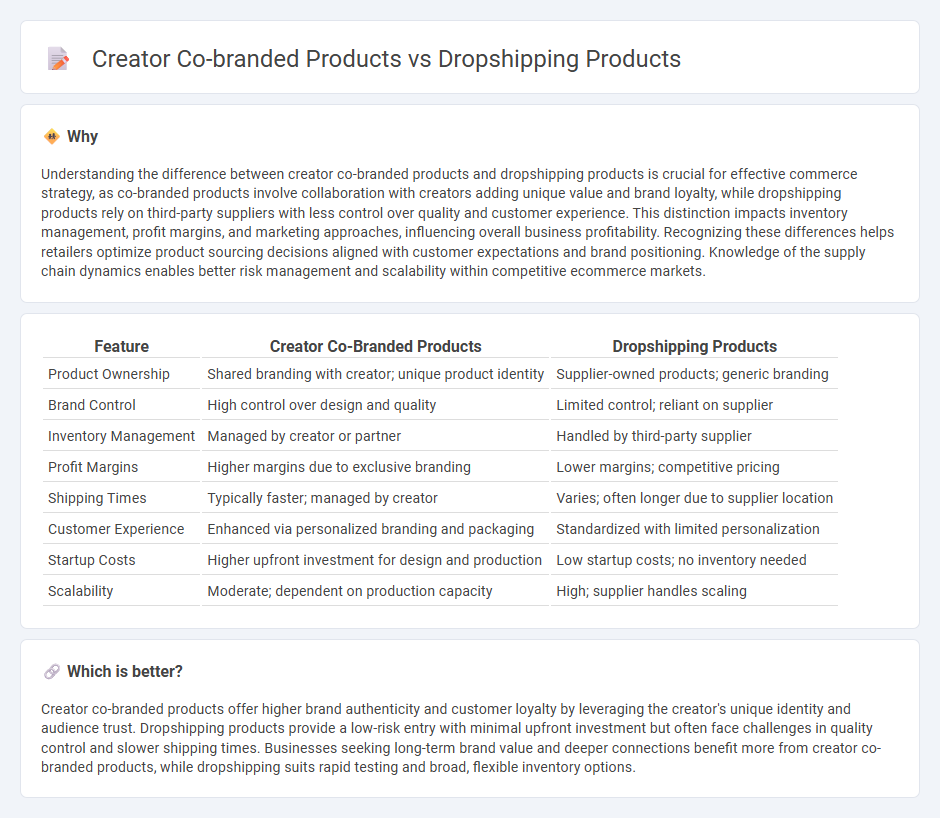
Creator co-branded products leverage the unique identity and influence of content creators, resulting in exclusive items that resonate deeply with their audiences and often boast higher profit margins. Dropshipping products enable sellers to offer a wide variety of goods without inventory risks by directly shipping items from suppliers to customers, streamlining the retail process. Explore how these commerce models can transform your business strategy for maximum engagement and revenue.
Why it is important
Understanding the difference between creator co-branded products and dropshipping products is crucial for effective commerce strategy, as co-branded products involve collaboration with creators adding unique value and brand loyalty, while dropshipping products rely on third-party suppliers with less control over quality and customer experience. This distinction impacts inventory management, profit margins, and marketing approaches, influencing overall business profitability. Recognizing these differences helps retailers optimize product sourcing decisions aligned with customer expectations and brand positioning. Knowledge of the supply chain dynamics enables better risk management and scalability within competitive ecommerce markets.
Comparison Table
| Feature | Creator Co-Branded Products | Dropshipping Products |
|---|---|---|
| Product Ownership | Shared branding with creator; unique product identity | Supplier-owned products; generic branding |
| Brand Control | High control over design and quality | Limited control; reliant on supplier |
| Inventory Management | Managed by creator or partner | Handled by third-party supplier |
| Profit Margins | Higher margins due to exclusive branding | Lower margins; competitive pricing |
| Shipping Times | Typically faster; managed by creator | Varies; often longer due to supplier location |
| Customer Experience | Enhanced via personalized branding and packaging | Standardized with limited personalization |
| Startup Costs | Higher upfront investment for design and production | Low startup costs; no inventory needed |
| Scalability | Moderate; dependent on production capacity | High; supplier handles scaling |
Which is better?
Creator co-branded products offer higher brand authenticity and customer loyalty by leveraging the creator's unique identity and audience trust. Dropshipping products provide a low-risk entry with minimal upfront investment but often face challenges in quality control and slower shipping times. Businesses seeking long-term brand value and deeper connections benefit more from creator co-branded products, while dropshipping suits rapid testing and broad, flexible inventory options.
Connection
Creator co-branded products leverage influencer or creator brand equity to enhance dropshipping product appeal, driving higher consumer trust and sales conversion. Dropshipping enables creators to market co-branded merchandise without inventory costs, streamlining logistics and expanding product offerings. This synergy optimizes e-commerce scalability by merging personalized branding with efficient supply chain management.
Key Terms
Inventory Management
Dropshipping products eliminate the need for upfront inventory investment, as suppliers handle storage and fulfillment, reducing overhead costs and risks associated with unsold stock. Creator co-branded products require managing limited inventory, often involving production timelines, stock level forecasting, and potentially warehousing or distribution challenges to maintain brand consistency and customer satisfaction. Explore strategies to optimize inventory management for both models to enhance your e-commerce business efficiency.
Brand Ownership
Dropshipping products typically offer limited brand ownership as the supplier controls inventory, packaging, and fulfillment, restricting the seller's ability to customize or enforce brand identity. In contrast, creator co-branded products enable full control over brand elements, allowing creators to design unique packaging, maintain quality standards, and build a distinct market presence. Explore how prioritizing brand ownership can elevate your business's long-term value and customer loyalty.
Profit Margin
Dropshipping products typically offer lower profit margins, ranging from 10% to 30%, due to reliance on third-party suppliers and increased competition. Creator co-branded products often yield higher profit margins of 40% to 70%, benefiting from exclusive branding, limited competition, and direct customer engagement. Explore how aligning your product strategy with margin optimization can boost your business success.
Source and External Links
150+ Dropshipping Products To Sell for Profit (2025) - This resource lists over 150 trending dropshipping categories and specific products, focusing on popular niches like apparel, beauty, home decor, office supplies, and electronics, with examples such as t-shirts, makeup brush sets, and phone accessories for entrepreneurs to consider in 2025.
100+ Best Dropshipping Products To Sell In 2025 - Highlights high-demand niches including print on demand, pet supplies, home decor, electronics, and health & fitness, with product examples like facial beauty rollers, phone tripods, and workout gear, emphasizing the importance of supplier quality in these growing markets.
Find Best Trending Dropshipping Products from US/EU - Aggregates trending dropshipping products from US and EU suppliers, helping store owners quickly find what's selling well across major platforms and stay ahead by regularly updating their catalog with proven, high-margin items.
 dowidth.com
dowidth.com